Abstract
The global increase in energy demand has triggered a global boom in the construction of hydropower dams worldwide affecting biological communities. Our objective is to study the zooplankton (Rotifera, Cladocera and Copepoda) community structure during and after the impoundment of a newly constructed reservoir, to provide valuable knowledge on species diversity, community structure and dynamics to be considered in future management plans. The impoundment period was characterized by increased species richness with high turnover because of the zooplankton’s high dispersal ability and reflected the inoculation of the reservoir with local fauna. Zooplankton during this period were also correlated negatively with depth and positively with total organic nitrogen and nitrate, highlighting the importance of trophic impact. The time following the impoundment reflected the colonization processes to more stable communities. The seasonality domination followed the Mediterranean pattern, with cold and warm periods being differentiated by changes in community structure, while abundance and biomass remained low throughout the studied period. Combined with the dominance of small-sized individuals, it resulted in low grazing pressure, indicating that zooplankton was not the factor controlling phytoplankton.
1. Introduction
Dams are becoming a pervasive feature of the landscape worldwide [1] with an unprecedented boom in dam construction in emerging economies. At present, about half of the planet’s major river systems are regulated by dams [2]. The construction of dams serves particular activities such as drinking water supply, irrigation, power generation, fish-farming, paddy-field management or wetland formation. Furthermore, the creation of reservoirs through dam construction offers a variety of recreational opportunities such as fishing, swimming and boating, and in case of excess water, they can be also used for flood control [3,4]. Still, hydropower dams and dams in general have an impact on the structure and functioning of aquatic ecosystems [5] by changing at least part of the ecosystem from a lotic to a lentic one. This leads to alterations in the hydraulic regime [6], sedimentation and nutrient cycling [7], and the modification of habitats [8]. Hydropower dams can alter periphyton biomass and phytoplankton densities and also induce algal blooms [9] in reservoirs affected by anthropogenic eutrophication, as well as affect zooplankton richness [10,11].
Zooplankton organisms occupy an important position in lake food webs, being sensitive at the same time to a number of environmental and anthropogenic impacts [12]. Their potential influence on critical ecosystem properties has long been recognized [13]. They affect the energy flow and nutrient availability between lower (e.g., phytoplankton) and higher trophic levels (e.g., fish) both directly and indirectly [14]. Direct effects include changes in biomass stock and community structure of planktonic organisms; thereby, zooplankters indirectly influence how other trophic levels affect ecosystem functioning (e.g., [12,15]). For example, co-occurrence of large-bodied cladocerans, mainly of the genus Daphnia, and calanoid copepods may effectively control the whole size spectrum of phytoplankton leading to increased water clarity [16,17]. Zooplankton also contribute to nutrient availability through excretion (e.g., ammonia and phosphorus) [18] and through respiration releasing CO2 into water, which can be used by phytoplankton organisms during photosynthesis [19,20].
Although zooplankton communities of natural lake ecosystems have long been studied and much is known of their compositional variation patterns (e.g., [21,22,23]), the corresponding studies of reservoirs are not so many (e.g., [24,25]) and even less are the studies reporting on the initial phase of their construction. The way zooplankton is assembled in newly constructed environments has been explored experimentally (e.g., [26,27,28]). Zooplankton species possess several life characteristics (diapause, encystment and production of resting eggs) that enable them to be transported through air, by animal vectors (e.g., mammals, birds and insects) and water connections and colonize new environments [29,30]. Regional processes (e.g., dispersal, colonization and extinction) and local parameters (e.g., chemical composition and limiting nutrients), including the presence/absence of strong competitors or predators, are the main factors structuring zooplankton communities [29].
In the present study, we describe the zooplankton community in a newly constructed reservoir, the Moglicë Reservoir, during and after its impoundment (the filling phase). The Moglicë Reservoir is situated in Albania, an understudied region of the Balkan Peninsula, considered a biodiversity hotspot. This study will provide valuable knowledge on species diversity, community structure and dynamics to be considered in future management plans. Thus, we hypothesized that zooplankton composition would be different during the impoundment period, reflecting the inoculation of the reservoir with local fauna, while the time following will reflect the colonization processes to more stable communities. To test that, we initially explored the structure of the encountered zooplankton community for two years after the dam construction. Next, different ‘phases’ of the studied period were identified using cluster analysis and changes in beta-diversity were studied. Finally, key abiotic and biological (phytoplankton) factors were studied to further identify their relationship with zooplankton community functioning during and after the impoundment.
2. Materials and Methods
2.1. Study Area
The Moglicë Reservoir (Figure 1) at 40°41′20.504″, N 20°27′5.825″ E is a newly constructed reservoir situated in the Devoll River basin in Albania. Its impoundment started in June 2019 and finished in April 2020 after the construction of a hydropower dam (construction activities started in 2015). The Moglicë Dam is an asphalt-core rock-filled structure and one of the highest dams of its kind in the world, being approximately 167 m high. The Moglicë Reservoir, in its highest regulated water level of 650 m above sea level (maximum water depth 125 m), has a surface area of 7.2 km2 and a catchment area of 1671 km2 and its storage capacity is 380 million m3 [31].
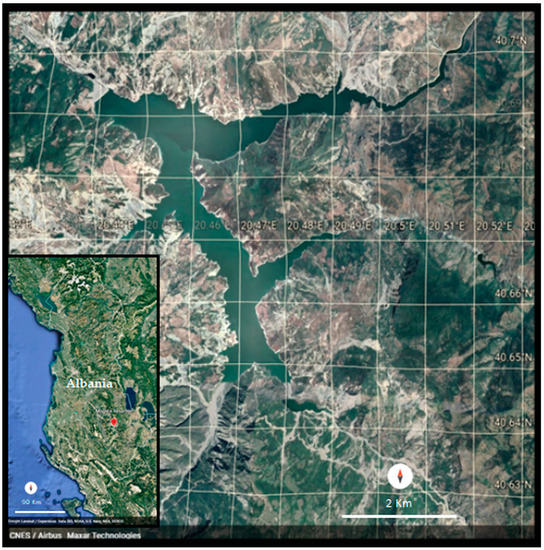
Figure 1.
Map of the Moglicë Reservoir in Albania.
The climate in the region of the Moglicë Reservoir is characterized by dry summers and wet winters. The coldest month is January and the hottest is July. The highest amount of precipitation is expected during the cold period of the year and the wettest months are November–December, while the driest month is July. The flow regime of the Devoll River is determined by precipitation and snow melt, resulting in two periods of high flow maximums, one in November/December and one in March/April [32].
2.2. Samplings
Samplings were carried out monthly from November 2019 to September 2021 and biweekly during the warm period of the year (May–October) at the sampling station located near the deepest point at the central part of the Moglicë Reservoir. No sampling was conducted in March 2020 because of COVID-19 restrictions. For zooplankton analysis, water samples were collected with plankton nets (50 and 100 μm mesh size, both nets were 100 cm long and their diameter was 40 cm). Two quantitative samples were collected through vertical hauls through the whole water column using each net; the sampling depth varied following the changes of maximum depth. Additional qualitative samples were taken with horizontal and vertical hauls using the plankton nets. All samples were preserved in 4% formalin.
During the samplings, the maximum depth and the Secchi depth were measured and additional water samples were collected for phytoplankton analysis and for nutrient measurements. Depth-integrated samples were collected from the euphotic zone using a Niskin-type sampler; for phytoplankton analysis, samples were preserved with Lugol solution, while samples for nutrient measurement were kept cool in the field and during their transportation to the laboratory.
2.3. Sample Analysis
Zooplankton samples were examined under a light microscope (magnifications 4 × 10, 20 × 10 and 40 × 10). Zooplankton species (from the qualitative samples) were identified down to the lowest possible taxonomic level with the use of proper taxonomic keys (for more details see [33]). All lines of taxonomic information (i.e., spellings and valid names) were confirmed using the Rotifer World Catalog [34], the List of Available Names (LAN) part Rotifera [35,36], the cladoceran checklist [37] and the World Register of Marine Species [38]. At least 400 individuals were identified in each sample. Zooplankton abundance (expressed as ind/L) was estimated using the quantitative samples (of 50 μm for rotifers and nauplii and of 100 μm for copepods and cladocerans) following the method of Bottrell et al. [39], Downing and Rigler [40] and Taggart [41]. For each sample (total volume of 100 or 50 mL), five counts of 1 mL subsamples were made on a Sedgwick–Rafter cell. At least 300 individuals were counted. For dry biomass estimations (expressed as μg/L), dry weight data and length–weight regressions were used (e.g., [42,43]). Species and taxonomical groups were considered dominant when comprising more than 20% of the total zooplankton abundance or biomass [44,45].
Phytoplankton samples were examined under a light inverted microscope Nikon ECLIPSE TE2000-S. Species identification was based on taxonomic keys and relevant papers and counting was done using the inverted microscope of Utermöhl [46]. At least 400 individuals were identified and counted per sample in sedimentation chambers. Phytoplankton biovolume was calculated using appropriate geometric formulae. The dimensions of 30 individuals (cells, filaments or colonies) of each dominant species were measured using the tools of a digital microscope camera (Nikon DS-L1).
Water samples were also collected for chemical analysis. Samples were analyzed according to the standard methods [47]. Nitrates, nitrites, ammonium and orthophosphates were determined after the filtration of water samples through 0.45 μm membranes by employing colorimetric methods. Total nitrogen and acid hydrolysable phosphorus were determined in unfiltrated samples after digestion. The N-species determined will be reported here as nitrogen and will be referred as dissolved inorganic nitrogen [DIN as sum of nitrate nitrogen (N-NO3), nitrite nitrogen (N-NO2), ammonium nitrogen (N-NH4)], total nitrogen (TN) and total organic nitrogen (TON as the difference of total nitrogen minus dissolved inorganic nitrogen TN-DIN). The P-forms discussed here are soluble reactive phosphorus (SRP) and acid hydrolysable phosphorus, expressed as total P (TP). Dissolved organic carbon (DOC) was measured by a TOC-VCSH analyzer. Alkalinity was determined titrimetrically at two end points, pH = 8.3 and pH = 4.5.
2.4. Data Analysis
To study species composition, the relative frequency of occurrence (i.e., the number of times a certain species occurred in all examined water bodies) was calculated for all species recorded. The species were then categorized as rare when the frequency of occurrence was up to 20%, as accessory when frequency of occurrence was between 20% and 50% and as constant when frequency of occurrence was greater than 50% [48]. Furthermore, diversity indices, Chao2 and second-order jackknife (Jackknife2) were used to estimate the potential richness using EstimateS 9.1 [49].
To identify the similarity of the zooplankton communities during and after the impoundment period, hierarchical cluster analysis (CLUSTER) based on the Bray–Curtis similarity index was performed on the presence/absence data matrix using group-average linking. Analysis of similarity (ANOSIM) and similarity percentage analysis (SIMPER) were used to test the significance levels and sources of variance between the zooplankton assemblages of the different groups derived by the hierarchical cluster analysis. The above analyses were performed using the Plymouth Routine in Multivariate Ecological Research (PRIMER) v.6 software package [50]. The beta diversity of zooplankton community during the different phases derived by CLUSTER analysis was estimated following Baselga’s approach [51,52], the Sorensen multiple-site dissimilarity (bSOR) and its two components, (a) spatial turnover in species composition [measured as Simpson dissimilarity (bSIM)] and (b) variation in species composition caused by nestedness (bNES) measured as nestedness fraction of Sorensen pair-wise dissimilarity using the ‘betapart’ R package version 1.5.6 [53] in R environment version 4.2.2 [54].
The significant relationships among dominant zooplankton taxa (based on biomass domination) and explanatory variables, both environmental and biological, were explored. The environmental explanatory variables were maximum depth, transparency (measured as Secchi depth) and nutrients (total organic nitrogen TN, nitrate nitrogen NO3− and total phosphorus TP). The biological explanatory variables were the phytoplankton groups Cryptophyceae, Bacillariophyceae and Chlorophyceae, which were dominant based on phytoplankton biovolume and Cyanobacteria. Samplings of April and May 2020 with missing environmental data were excluded from the analysis. All data were log(x + 1) transformed because of the occurrence of zero values. Initially, a detrended correspondence analysis (DCA) was performed and the longest gradient was shorter than 3.0; thus, redundancy analysis (RDA) was selected as a suitable approach to relate biological and environmental data. The statistical significance of the variation in the variables and the overall significance of the ordination were tested with the Monte Carlo permutation test (as default settings of 499 unrestricted permutations; p < 0.05). All variables exhibited an inflation factor <4. All analyses were performed with the CANOCO program version 4.5 [55].
Moreover, the grazing potential index (GP) was calculated as a measure of the potential top-down control of phytoplankton by zooplankton showing the percentage of the phytoplankton biomass ingested per day. More specifically, the modified GP (in %/day) [56,57,58] was calculated using Equation (1) based on weighted dry biomass of zooplankton and phytoplankton groups. The weighted phytoplankton groups comprise the edible phytoplankton biomass (BED) according to Equation (2). The relative edibility of the phytoplankton ranges from very good (1) to not at all (0) edible.
where B is the dry biomass (mg/L) of rotifers (ROT), cladocerans (CLAD), copepods (COP), cyanobacteria (CYANO), chlorophytes (CHLORO), chrysophytes (CHRYSO), cryptophytes (CRYPTO), prymnesiophytes (PRYMNESIO), diatoms (DIATOMS) and dinophytes (DINO).
3. Results
3.1. Species Composition
A total of 89 zooplankton taxa were identified in the Moglicë Reservoir during the study period. The recorded taxa consisted of 61 Rotifera, 18 Cladocera, 9 Copepoda and 1 Ostracoda; most of them were rare (60% contribution) (Table 1, Figure 2a). Lecane was the most diverge genus with 7 species, followed by Polyarthra with 4 species.

Table 1.
List of zooplankton taxa recorded in the Moglicë Reservoir and their occurrence based on frequency of occurrence (F.O.).
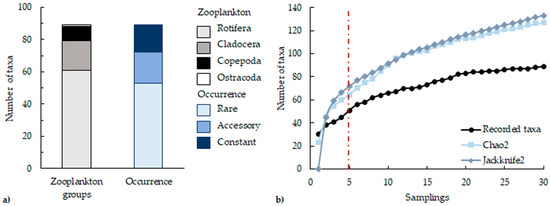
Figure 2.
(a) Contribution of zooplankton group and occurrence’s groups to the total recorder taxa, (b) estimation of diversity using Chao2 and Jackknife2; red dashed line indicates the end of the impoundment period.
Two estimates of total species richness showed that the potential species richness should account for up to 127 and 133 species according to Chao2 and Jackknife2, respectively (Figure 2b). Therefore, the efficiency percentage of species estimated varied from 67 to 70% (Jackknife2 and Chao2, respectively) for the Moglicë Reservoir.
CLUSTER analysis revealed samplings that were grouped together, creating five groups (ANOSIM: R = 0.6791, p = 0.001) (Figure 3). Group A included the samplings during the impoundment period (from November 2019 to February 2020), group B included only the April 2020 sampling as a transitional sampling (maximum depth 103 m) and group C included the rest of the samplings of the first year (May 2020 to November 2020), while group D included samplings from the warm period of the second year (from May 2021 to September 2021) and group E included samplings from the cold period of the second year (from December 2020 to March 2021). The similarity within groups was mainly due to the contribution of rotifers (except for group C) (Table S1, showing the most contributing taxa to the similarity of the groups). The pairwise comparison of the three groups revealed that their average dissimilarity ranged between 47–64% (Table S2, showing the most contributing taxa to the pairwise dissimilarity of the groups).
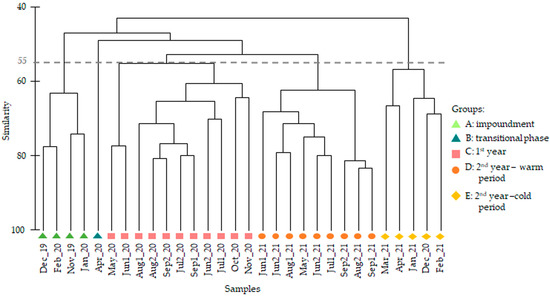
Figure 3.
Dendrogram for clustering based on the Bray–Curtis similarity index applied on presence/absence data for the samples from the Moglicë Reservoir.
We considered that the sampling period was divided into four phases, the impoundment period (groups A and B), the first year (group C), the second year’s warm period (group D) and the second year’s cold period (group E). In terms of beta diversity, zooplankton compositional variation was attributed to species turnover (79%) and nestedness (21%). Turnover was higher during the pair-wise comparisons of the different phases, with the highest values being recorded during the impoundment—second year’s warm period (93%) and the impoundment—first year period (84%) (Table 2). During these periods, the number of pelagic and littoral taxa showed a gradual decrease through the second year (Figure 4).

Table 2.
Zooplankton beta diversity according to relative turnover (bSIM/bSOR) and nestedness (bNES/bSOR) for each phase of the sampling period.
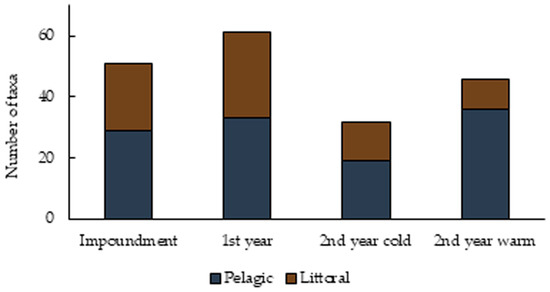
Figure 4.
Number of pelagic and littoral taxa during the different phases of the Moglicë Reservoir.
3.2. Abundance-Biomass
Total abundance ranged from 1.89 ind/L in February 2021 to 37.74 ind/L in June (first sampling) 2021 (Figure 5). Two peaks were recorded during the warm period in May and in September in both years. Rotifers were dominant both in the warm and cold period except for seven samplings. Cladocerans dominated because of the presence of Daphnia cucullata and/or Diaphanosoma mongolianum, while copepods dominated in 83% of the samplings with nauplii dominating in the copepods’ community in all samplings (dominance from 20 to 96%) except April 2021 (14%).
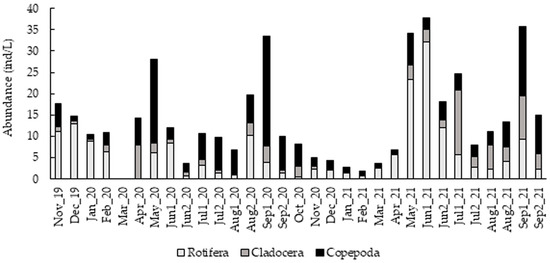
Figure 5.
Total zooplankton abundance (ind/L) in the Moglicë Reservoir during November 2019–September 2021.
Total biomass ranged from 0.89 μg/L in January (2021) to 60.92 μg/L in May (2020) (Figure 6). Biomass was generally low <40 μg/L and the highest values were recorded in April and May in 2020 and in May and September in 2021. Cladocerans dominated from February to July during the first year and from June to September during the second year. Copepods dominated during the whole period contributing from 46% to 98% to total biomass except from December (2019) and January (2020) when rotifers dominated (87% and 73% contribution, respectively).
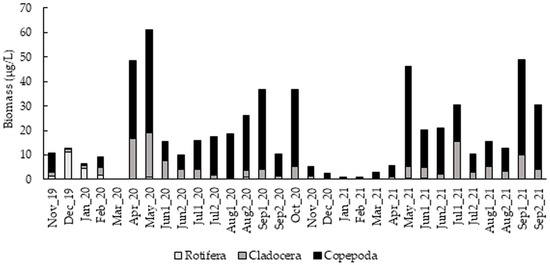
Figure 6.
Total zooplankton biomass (μg/L) in the Moglicë Reservoir during November 2019–September 2021.
3.3. Zooplankton Relations with Phytoplankton and Environmental Variables
3.3.1. Environmental Parameters
Summary statistics of the studied parameters are shown in Table 3. Maximum depth ranged from 47 to 125 m and Secchi depth from 1.1 to 4.2 m. Total nitrogen concentrations ranged from 0.33 to 3.67 mg N/L. Nitrate was the dominant inorganic nitrogen species, whereas nitrite and ammonium were found at low levels. Occasionally, organic nitrogen exhibited relatively high contribution to TN (>40%) (Figure S1). The concentration of total phosphorus ranged from <0.002 up to 0.060 mg P/L. Soluble reactive phosphorus was relatively low and did not exceed 0.019 mg P/L (Figure S1).

Table 3.
Summary statistics of environmental and chemical parameters in the Moglicë Reservoir.
3.3.2. Phytoplankton Community
Phytoplankton biomass ranged from to 0.09 to 5.69 mg/L in the Moglicë Reservoir during November 2019–September 2021 (Figure 7). The main dominant phytoplankton groups where Bacillariophyceae and Cryptophyceae (>70% contribution to total phytoplankton biomass) and occasionally Chlorophyceae and Chrysophyceae. Cyanobacteria were present but in low numbers.
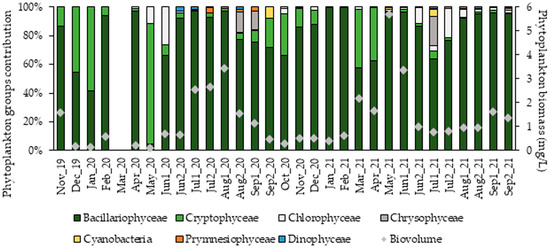
Figure 7.
Total phytoplankton biomass (mg/L) in the Moglicë Reservoir during November 2019–September 2021.
3.3.3. Redundancy Analysis
To visualize the relationships between zooplankton taxa and explanatory variables (both environmental and biological), redundancy analysis (RDA) was performed (Figure 8). The first two axes together explained 72.8% of the total data variability. According to the results, the impoundment period was differentiated and situated right to the first axis and was significantly positively related to increased total organic nitrogen and nitrate nitrogen, and negatively to maximum depth (Figure 8). The important phytoplankton groups according to the second axis were Bacillarophyceae and Cryptophyceae, indicating a positive relation among Cryptophyceae and cyclopoid copepodites and Acanthocyclops adults.
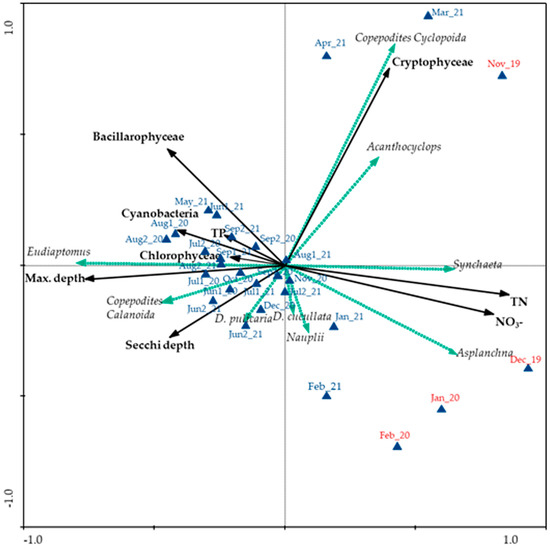
Figure 8.
Triplot diagram of zooplankton dominating taxa, explanatory variables and samples in RDA analysis. Blue triangles indicate the samplings and red lettering the samplings during the impoundment period, solid arrows indicate the explanatory variables (phytoplankton groups Bacillarophyceae, Cryptophyceae and Cyanobacteria), maximum depth (Max. depth) and Secchi depth, total organic nitrogen (TN), nitrate nitrogen (NO3−) and total phosphorus (TP), and the green dotted lines indicate zooplankton dominating taxa based on biomass.
3.3.4. Grazing Potential Index
The grazing potential (GP) index ranged from 0.21 to 102.62% per day in the Moglicë Reservoir (Figure 9). GP took high values >55 only in May (second sampling) 2020 when the lower phytoplankton biomass was recorded.
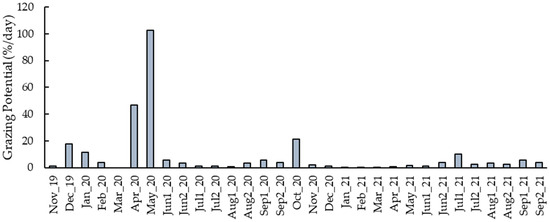
Figure 9.
The grazing potential (GP) index in the Moglicë Reservoir during November 2019–September 2021.
4. Discussion
This is the first study of the zooplankton community of the Moglicë Reservoir, a newly constructed reservoir in Albania. Even though the zooplankton communities have not been studied extensively in Albania, the majority of the species recorded in the present study have been recorded in other Albanian lakes (e.g., [59,60]), as well as in cross-border lakes of the area such as Mikri and Megali Prespa, Gistova, Ohrid and Shkodra (e.g., [60,61,62,63,64]). Nevertheless, for rotifers, based on our findings, 10 species (i.e., Ascomorpha agilis, Brachionus fernandoi, Colurella hindenburgi, Conochilus dossuarius, Dicranophoroides caudatus, Eothinia elongata, Keratella tropica, Lepadella quadricarinata, Polyarthra luminosa and Trichocerca insulana) are considered as new records for Albania’s rotifer fauna, compared to a checklist that has been published for Albania [60]. Among them, D. caudatus and E. elongata are the first representatives of the respective genera in Albania. As for Brachionus calyciflorus Pallas, 1776, which has been previously recorded in Albania [60], it has been identified as a species complex [61] including B. fernandoi [65], which we identified in the Moglicë Reservoir.
In terms of species richness, a high number of species (89 species) was recorded with rotifers dominating. Generally, rotifer dominance is the case for freshwater ecosystems; however, higher numbers of cladocerans and copepods were recorded compared to other European lakes (zooplankton communities of European lakes have usually high numbers of rotifers, 3–10 cladocerans and 1–5 copepods) [66]. Nevertheless, this mainly refers to either natural lakes or well-established lentic environments. The present study encompasses the impoundment period and the two years following the reservoir’s establishment, thus the transition from a lotic to a lentic environment. Therefore, the resulting community was the combination of two different communities, the riverine and the lacustrine [67]. Such transit communities need a relatively short time to assemble, i.e., zooplankton species colonizing new lakes, and remain species rich for the first 20 years, and then it begins to decrease with the ageing of the system [68].
In general, newly formed water bodies are characterized by increased species richness in the early phase, contributing to species turnover in terms of beta-diversity [69,70]; this was also the case of the Moglicë Reservoir. Turnover defined as the average of species gains and losses relative to species richness implies the replacement of some species by others [51]. Zooplankton can passively disperse and invade new ecosystems through a wide variety of vectors via natural (flooding, wind or animals) or human-mediated mechanisms (canals or fish stocking) [30]. Thus, in such newly established ecosystems, zooplankton communities are inoculated with the local freshwater fauna from the nearby water bodies [29]. The establishment of new populations, even from only one individual, is possible under optimal environmental conditions because of the parthenogenetic reproduction and the short life cycle of rotifers and cladocerans [30]. However, the colonization success and even the population recovery of copepods is lower and is highly influenced by mate limitation, since mature male–female encounters may be too low to sustain the population [30,71]. So, there are species that are the first to arrive in a newly created environment and establish successful populations, others that will arrive but will not be able to establish successful populations and can be accidentally recorded and others that will arrive later. This explains the high contribution of species turnover when comparing the impoundment with the other phases, since various zooplankton species assembled at the Moglicë Reservoir and only some of them colonized it based on their ability to tolerate local conditions. Besides, the majority of the identified taxa (57%) were recorded during the impoundment period, while only 19% of the total species were constantly recorded.
Species diversity differentiated the period during and after the impoundment of the Moglicë Reservoir with Ceriodaphnia reticulata, Kellicottia longispina, Acanthocyclops robustus group and Cyclops abyssorum group playing a pivotal role. In more detail, C. reticulata was constantly recorded during the first year, both during and after the impoundment, but not during the second year. The C. abyssorum group was only recorded after the impoundment during the first year. K. longispina was constantly recorded through the second year both during the cold and the warm periods. The A. robustus group was a constant species during both years, with higher numbers during the warm period differentiating the cold and the warm periods of the second year. The crustacean C. reticulata and C. abyssorum groups are widely distributed in Europe, reported in mountain areas in small lakes, small waterbodies, rivers, reservoirs, etc. [72]. They may have passively dispersed to the Moglicë Reservoir and established populations during the first year, but they did not maintain these populations during the second year because of environmental factors, e.g., depth and/or temperature.
Generally, the impoundment period represented a more changing environment as seen by the samplings correlated with the explanatory variables. So, the samplings during the impoundment were negatively correlated with maximum depth and positively with TN and NO3−. Depth ranged from 47 m to 103 m and the higher values of TN and NO3− were recorded during the impoundment, while in the following samplings, depth increased from 92 m to 125 m and TN and NO3− remained in lower levels. In newly constructed reservoirs, nutrient concentrations are higher during periods of higher inflow (e.g., [73,74]). This trophic surge (upsurge) results from the leaching and decomposition of organic matter from newly inundated terrestrial areas and is well-expected for reservoirs (trophic surge hypothesis, e.g., [75,76]). During the first year(s) of the impoundment, the surge phase, a large influx of allochthonous inorganic nutrients and organic detritus, leads to increased primary production, which can be mitigated by short hydraulic retention time and high inorganic turbidity [77]. This was highly evident in the Moglicë Reservoir during the impoundment in September of 2019 (prior to the sampling period), when increased phytoplankton biomass was recorded (>2 mg/L), dominated by pioneer chlorophyte species. However, the low phytoplankton biomass recorded in general was due to hydrological factors, such as short water retention time, and not due to nutrients concentration, which were available throughout the study. Despite the low biomass, Bacillariophyceae was the dominant group almost during the whole studied period, while Cryptophyceae was correlated with cyclopoids copepodites. Both phytoplankton groups are considered as potential good food sources for zooplankton [78] with edible biomass ranging from 64% to 93% of the total biomass.
The zooplankton community of the Moglicë Reservoir followed the seasonality pattern of Mediterranean lakes (both natural and reservoirs) [22], with rotifers mainly dominating in terms of abundance and copepods in term of biomass. Cladocerans dominated only during the warm period because of Diaphanosoma mongolianum, Daphnia cucullata and Daphnia pulicaria. The domination of rotifers and nauplii (copepod developmental stage) led to the domination of small-bodied individuals (mainly up to 500 μm) in abundance throughout the whole studied period. Fish predation pressure has a major impact on the size of zooplankton communities throughout the year, even during winter months [75], because of selective feeding on larger-bodied individuals. Intense fish predation is expected when fish communities are dominated by planktivorous species [79,80], or even by omnivorous species [81] or after the spawning season because of high numbers of young of the year fish [82,83]. In the Mediterranean region, the increased temperature results in the extended period of fish reproduction and thus a longer period of intense fish predation on zooplankton [22]. As a result, Mediterranean lakes are characterized by small-bodied zooplankton communities not being able to exert any control on the phytoplankton biomass [22]. The Moglicë Reservoir is inhabited by a planktivorous fish, Alburnus scoranza (Heckel and Kner, 1857), which has the highest relative abundance in the fish communities, indicating that the fish fauna can impose pressure on zooplankton [84].
The dominance of small-bodied individuals led to the low grazing pressure of zooplankton to phytoplankton depicted through the grazing potential (GP) values. GP values were quite low in the Moglicë Reservoir compared to other lakes where it has been applied [85], indicating that zooplankton during the sampling period was not the factor controlling phytoplankton. In general, lakes with high GP values exhibit high zooplankton biomass dominated by large cladocerans and/or calanoids, while lakes with low GP values have increased phytoplankton biomass and/or domination of small-bodied zooplankton. In the case of the Moglicë Reservoir, the high GP values in April and May 2020 were recorded because of low phytoplankton biomass, while the low GP values derived from the domination of small-bodied zooplankton.
In conclusion, a high number of zooplankton species was recorded in the Moglicë Reservoir, with the majority of the identified taxa being recorded during the impoundment period, while only 19% of the total species were constantly recorded. The impoundment period represented a more changing environment as seen by the recorded trophic surge. However, low phytoplankton biomass was recorded in general because of hydrological factors and not because of nutrients concentration or grazing pressure from zooplankton. The zooplankton community of the Moglicë Reservoir followed the seasonality pattern of Mediterranean lakes and was dominated by small-sized individuals, probably because of fish predation.
Supplementary Materials
The following supporting information can be downloaded at https://www.mdpi.com/article/10.3390/d15020257/s1: Figure S1: Nutrients concentration and relative contribution; Table S1: Results of SIMPER concerning the similarity of groups; Table S2: Results of SIMPER concerning the dissimilarity of groups.
Author Contributions
Conceptualization, G.S. and E.M.; formal analysis, G.S., M.K., M.D., A.K. and I.P.; investigation, G.S., M.K., D.V., A.K., I.P., M.M.-G. and E.M.; resources, E.M., M.M.-G. and D.V.; data curation, G.S., M.D., A.K., I.P. and E.M.; writing—original draft preparation, G.S., M.K., M.D., D.V., A.K., I.P., M.M.-G. and E.M.; writing—review and editing, G.S., M.K., M.D., D.V., A.K., I.P., M.M.-G. and E.M.; visualization, G.S., M.D., A.K. and I.P.; supervision, E.M., M.M.-G. and D.V.; project administration, E.M.; funding acquisition, E.M., M.M.-G., M.K. and G.S. All authors have read and agreed to the published version of the manuscript.
Funding
This research was funded by Devoll Hydropower Sh.a, based on a joint agreement.
Data Availability Statement
Data is contained within the article or supplementary material.
Conflicts of Interest
The authors declare no conflict of interest. All samples were collected by References.
References
- Stickler, C.M.; Coe, M.T.; Costa, M.H.; Nepstad, D.C.; McGrath, D.G.; Dias, L.C.P.; Rodrigues, H.O.; Soares-Filho, B.S. Dependence of Hydropower Energy Generation on Forests in the Amazon Basin at Local and Regional Scales. Proc. Natl. Acad. Sci. USA 2013, 110, 9601–9606. [Google Scholar] [CrossRef]
- Grill, G.; Lehner, B.; Thieme, M.; Geenen, B.; Tickner, D.; Antonelli, F.; Babu, S.; Borrelli, P.; Cheng, L.; Crochetiere, H. Mapping the World’s Free-Flowing Rivers. Nature 2019, 569, 215–221. [Google Scholar] [CrossRef]
- World Commission on Dams Dams and Development: A New Framework for Decision-Making. Environ. Manag. Health 2001, 12, 444–445. [CrossRef]
- Kornijów, R. Controversies around Dam Reservoirs: Benefits, Costs and Future. Ecohydrol. Hydrobiol. 2009, 9, 141–148. [Google Scholar] [CrossRef]
- Bartle, A. Hydropower Potential and Development Activities. Energy Policy 2002, 30, 1231–1239. [Google Scholar] [CrossRef]
- Zohary, T.; Ostrovsky, I. Ecological Impacts of Excessive Water Level Fluctuations in Stratified Freshwater Lakes. Inland Waters 2011, 1, 47–59. [Google Scholar] [CrossRef]
- García, A.; Jorde, K.; Habit, E.; Caamaño, D.; Parra, O. Downstream Environmental Effects of Dam Operations: Changes in Habitat Quality for Native Fish Species. River Res. Appl. 2011, 27, 312–327. [Google Scholar] [CrossRef]
- Morita, K.; Morita, S.H.; Yamamoto, S. Effects of Habitat Fragmentation by Damming on Salmonid Fishes: Lessons from White-Spotted Charr in Japan. Ecol. Res. 2009, 24, 711–722. [Google Scholar] [CrossRef]
- Tonkin, J.D.; Death, R.G.; Joy, M.K. Invertebrate Drift Patterns in a Regulated River: Dams, Periphyton Biomass or Longitudinal Patterns? River Res. Appl. 2009, 25, 1219–1231. [Google Scholar] [CrossRef]
- Zhou, S.; Tang, T.; Wu, N.; Fu, X.; Jiang, W.; Li, F.; Cai, Q. Impacts of Cascaded Small Hydropower Plants on Microzooplankton in Xiangxi River, China. Acta Ecol. Sin. 2009, 29, 62–68. [Google Scholar] [CrossRef]
- de Souza, C.A.; Vieira, L.C.G.; Legendre, P.; de Carvalho, P.; Velho, L.F.M.; Beisner, B.E. Damming Interacts with the Flood Pulse to Alter Zooplankton Communities in an Amazonian River. Freshw. Biol. 2019, 64, 1040–1053. [Google Scholar] [CrossRef]
- Jeppesen, E.; Nõges, P.; Davidson, T.A.; Haberman, J.; Nõges, T.; Blank, K.; Lauridsen, T.L.; Søndergaard, M.; Sayer, C.; Laugaste, R.; et al. Zooplankton as Indicators in Lakes: A Scientific-Based Plea for Including Zooplankton in the Ecological Quality Assessment of Lakes According to the European Water Framework Directive (WFD). Hydrobiologia 2011, 676, 279–297. [Google Scholar] [CrossRef]
- Sterner, R.W. Role of Zooplankton in Aquatic Ecosystems. In Encyclopedia of Inland Waters; Elsevier Inc.: Amsterdam, The Netherlands, 2009; pp. 678–688. ISBN 978-0-12-370626-3. [Google Scholar]
- Hébert, M.-P.; Beisner, B.E.; Maranger, R. Linking Zooplankton Communities to Ecosystem Functioning: Toward an Effect-Trait Framework. J. Plankton Res. 2017, 39, 3–12. [Google Scholar] [CrossRef]
- Caroni, R.; Irvine, K. The Potential of Zooplankton Communities for Ecological Assessment of Lakes: Redundant Concept or Political Oversight? Biol. Environ. Proc. R. Ir. Acad. 2010, 110, 35–53. [Google Scholar] [CrossRef]
- Lampert, W.; Fleckner, W.; Rai, H.; Taylor, B.E. Phytoplankton Control by Grazing Zooplankton: A Study on the Spring Clear-Water Phase1. Limnol. Oceanogr. 1986, 31, 478–490. [Google Scholar] [CrossRef]
- Lathrop, R.C.; Carpenter, S.R.; Robertson, D.M. Summer Water Clarity Responses to Phosphorus, Daphnia Grazing, and Internal Mixing in Lake Mendota. Limnol. Oceanogr. 1999, 44, 137–146. [Google Scholar] [CrossRef]
- Hessen, D.O. Nutrient Element Limitation of Zooplankton Production. Am. Nat. 1992, 140, 799–814. [Google Scholar] [CrossRef]
- Elser, J.J.; Goldman, C.R. Zooplankton Effects on Phytoplankton in Lakes of Contrasting Trophic Status. Limnol. Oceanogr. 1991, 36, 64–90. [Google Scholar] [CrossRef]
- Steinberg, D.K.; Carlson, C.A.; Bates, N.R.; Goldthwait, S.A.; Madin, L.P.; Michaels, A.F. Zooplankton Vertical Migration and the Active Transport of Dissolved Organic and Inorganic Carbon in the Sargasso Sea. Deep Sea Res. Part Oceanogr. Res. 2000, 47, 137–158. [Google Scholar] [CrossRef]
- Sommer, U.; Gliwicz, Z.M.; Lampert, W.; Duncan, A. The PEG-Model of Seasonal Succession of Planktonic Events in Fresh Waters. Arch. Hydrobiol. 1986, 106, 433–471. [Google Scholar] [CrossRef]
- Moustaka-Gouni, M.; Michaloudi, E.; Sommer, U. Modifying the PEG Model for Mediterranean Lakes—No Biological Winter and Strong Fish Predation. Freshw. Biol. 2014, 59, 1136–1144. [Google Scholar] [CrossRef]
- Paquette, C.; Gregory-Eaves, I.; Beisner, B.E. Environmental Drivers of Taxonomic and Functional Variation in Zooplankton Diversity and Composition in Freshwater Lakes across Canadian Continental Watersheds. Limnol. Oceanogr. 2022, 67, 1081–1097. [Google Scholar] [CrossRef]
- Muñoz-Colmenares, M.E.; Vicente, E.; Soria, J.M.; Miracle, M.R. Zooplankton Changes at Six Reservoirs in the Ebro Watershed, Spain. Limnetica 2021, 40, 279–294. [Google Scholar] [CrossRef]
- Sampaio, E.V.; Rocha, O.; Matsumura-Tundisi, T.; Tundisi, J.G. Composition and Abundance of Zooplankton in the Limnetic Zone of Seven Reservoirs of the Paranapanema River, Brazil. Braz. J. Biol. 2002, 62, 525–545. [Google Scholar] [CrossRef] [PubMed]
- Parkes, S.M.; Duggan, I.C. Are Zooplankton Invasions in Constructed Waters Facilitated by Simple Communities? Divers. Distrib. 2012, 18, 1199–1210. [Google Scholar] [CrossRef]
- Jenkins, D.G. Dispersal-Limited Zooplankton Distribution and Community Composition in New Ponds. Hydrobiologia 1995, 313, 15–20. [Google Scholar] [CrossRef]
- Frisch, D.; Cottenie, K.; Badosa, A.; Green, A.J. Strong Spatial Influence on Colonization Rates in a Pioneer Zooplankton Metacommunity. PLoS ONE 2012, 7, e40205. [Google Scholar] [CrossRef]
- Cohen, G.M.; Shurin, J.B. Scale-Dependence and Mechanisms of Dispersal in Freshwater Zooplankton. Oikos 2003, 103, 603–617. [Google Scholar] [CrossRef]
- Havel, J.E.; Shurin, J.B. Mechanisms, Effects, and Scales of Dispersal in Freshwater Zooplankton. Limnol. Oceanogr. 2004, 49, 1229–1238. [Google Scholar] [CrossRef]
- Statkraft Moglice Hydropower Plant. Available online: https://www.statkraft.com/about-statkraft/where-we-operate/albania/moglice-hydropower-plant/ (accessed on 29 December 2022).
- ESIA. Devoll Hydropower Project Engineering Services Development Phase; ESIA: Hawthorn, Australia, 2011; p. 58. [Google Scholar]
- Stamou, G.; Katsiapi, M.; Moustaka-Gouni, M.; Michaloudi, E. Trophic State Assessment Based on Zooplankton Communities in Mediterranean Lakes. Hydrobiologia 2019, 844, 83–103. [Google Scholar] [CrossRef]
- Jersabek, C.D.; Leitner, M.F. The Rotifer World Catalog. World Wide Web Electronic Publication. Available online: http://www.rotifera.hausdernatur.at/ (accessed on 29 December 2022).
- Segers, H.; De Smet, W.H.; Fischer, C.; Fontaneto, D.; Michaloudi, E.; Wallace, R.L.; Jersabek, C.D. Towards a List of Available Names in Zoology, Partim Phylum Rotifera. Zootaxa 2012, 3179, 61–68. [Google Scholar] [CrossRef]
- International Commission on Zoological Nomenclature Rotifer Parts of the LAN. Available online: https://www.iczn.org/list-of-available-names/rotifer-lan/ (accessed on 26 January 2023).
- Kotov, A.; Forró, L.; Korovchinsky, N.M.; Petrusek, A. World Checklist of Freshwater Cladocera Species. Available online: http://fada.biodiversity.be/group/show/17 (accessed on 17 December 2022).
- WoRMS Editorial Board World Register of Marine Species. Available online: https://www.marinespecies.org (accessed on 30 December 2022).
- Bottrell, H.C. A Review of Some Problems in Zooplankton Production Studies. Norw. J. Zool 1976, 24, 419–456. [Google Scholar]
- Downing, J.A.; Rigler, F.H. A Manual on Methods for the Assessment of Secondary Productivity in Fresh Waters; Blackwell Scientific Publications: Hoboken, NJ, USA, 1984; ISBN 978-0-632-00616-8. [Google Scholar]
- Taggart, C.T. Hypolimnetic Aeration and Zooplankton Distribution: A Possible Limitation to the Restoration of Cold-Water Fish Production. Can. J. Fish. Aquat. Sci. 1984, 41, 191–198. [Google Scholar] [CrossRef]
- Dumont, H.J.; Van de Velde, I.; Dumont, S. The Dry Weight Estimate of Biomass in a Selection of Cladocera, Copepoda and Rotifera from the Plankton, Periphyton and Benthos of Continental Waters. Oecologia 1975, 19, 75–97. [Google Scholar] [CrossRef] [PubMed]
- Michaloudi, E. Dry Weights of the Zooplankton of Lake Mikri Prespa (Macedonia, Greece). Belg. J. Zool 2005, 135, 223–227. [Google Scholar]
- Haberman, J. An Ecological Characterization of the Rotifers Dominating in the Pelagic Region of Lakes Peipsi-Pihkva and Võrtsjärv. Product. Est. Fresh Waters Est. Contrib. Int. Biol. Programme 1976, 10, 35–59. [Google Scholar]
- Haberman, J. An Ecological Characterization of the Crustaceans (Cladocera, Copepoda) and Dreissena Polymorpha Juv. Dominating in the Pelagic Region of Lakes Peipsi-Pihkva and Võrtsjärv. Product. Est. Fresh Waters Est. Contrib. Int. Biol. Programme 1976, 10, 60–99. [Google Scholar]
- Utermöhl, H. Methods of Collecting Plankton for Various Purposes Are Discussed. SIL Commun. 1953–1996 1958, 9, 1–38. [Google Scholar] [CrossRef]
- APHA. Standard Methods for the Examination of Water and Wastewater; APHA: Washington, DC, USA, 2012. [Google Scholar]
- Simões, N.R.; Nunes, A.H.; Dias, J.D.; Lansac-Tôha, F.A.; Velho, L.F.M.; Bonecker, C.C. Impact of Reservoirs on Zooplankton Diversity and Implications for the Conservation of Natural Aquatic Environments. Hydrobiologia 2015, 758, 3–17. [Google Scholar] [CrossRef]
- Colwell, R.K.; Michelotto, A.S.; Javier, S.C.C.; Toniotti, D.G.A. EstimateS_9.1_Windows 2022. Available online: osf.io/su57f (accessed on 15 December 2022).
- Clarke, K.R.; Gorley, R.N. Primer. Primer-E Plymouth 2006, 115. [Google Scholar]
- Baselga, A. Partitioning the Turnover and Nestedness Components of Beta Diversity. Glob. Ecol. Biogeogr. 2010, 19, 134–143. [Google Scholar] [CrossRef]
- Baselga, A.; Orme, D.; Villeger, S.; de Bortoli, J.; Lepieur, F.; Logez, M. Betapart: Partitioning Beta Diversity into Turnover and Nestedness Components. R Package Version 2022, 1, 6. [Google Scholar]
- Baselga, A.; Orme, D.; Villeger, S.; De Bortoli, J.; Leprieur, F.; Baselga, M.A. Package ‘Betapart’ 1.5.6. 2022. Available online: https://CRAN.R-project.org/package=betapart (accessed on 10 January 2023).
- R Core Team. A Language and Environment for Statistical Computing. 2022. Available online: https://www.r-project.org/ (accessed on 10 January 2023).
- Ter Braak, C.J.F.; Smilauer, P. CANOCO Reference Manual and CanoDraw for Windows User’s Guide: Software for Canonical Community Ordination (Version 4.5); WUR: Wageningen, The Netherlands, 2002. [Google Scholar]
- Jeppesen, E.; Peder Jensen, J.; Søndergaard, M.; Lauridsen, T.; Junge Pedersen, L.; Jensen, L. Top-down Control in Freshwater Lakes: The Role of Nutrient State, Submerged Macrophytes and Water Depth. Hydrobiologia 1997, 342, 151–164. [Google Scholar] [CrossRef]
- Arp, W.; Deneke, R. Untersuchungen des Phyto- und Zooplanktons Schleswig-Holsteinischer Seen 2006; Im Auftrag des Landesamtes für Natur und Umwelt Schleswig-Holsteins, Abteilung: Berlin, Germany, 2007; p. 225. [Google Scholar]
- Arp, W.; Kasten, J.; Maier, G. Untersuchungen Des Phyto- Und Zooplanktons Schleswig-Holsteinischer Seen 2009; Im Auftrag des Landesamtes für Natur und Umwelt Schleswig-Holsteins, Abteilung: Berlin, Germany, 2010; p. 248. [Google Scholar]
- Kozhuharov, D. The Zooplankton from Some Lakes and Ponds in North Albania with Different Size and Altitude. Hist. Nat. Bulg. 2000, 11, 33–37. [Google Scholar]
- Shumka, S. Checklist of Rotifer Species from Albania (Phylum Rotifera). Opusc. Zool. Bp. 2021, 52, 99–109. [Google Scholar] [CrossRef]
- Michaloudi, E.; Zarfdjian, M.; Economidis, P.S. The Zooplankton of Lake Mikri Prespa. Hydrobiologia 1997, 361, 77–94. [Google Scholar] [CrossRef]
- Shehu, M.; Serravalle, F.; Alfonso, G.; Moscatello, S.; Belmonte, G. The Alpine Gistova (Mount Gramos, Albania-Greece Border) Biodiversity of an Isolated Microcosm. Thalass. Salentina 2009, 32, 53–62. [Google Scholar] [CrossRef]
- Stamou, G.; Savva, A.; Demertzioglou, M.; Michaloudi, E. Diversity of Rotifera (Subclass: Monogononta) from Inland Water Bodies in Greece: An Updated Checklist. Diversity 2022, 14, 451. [Google Scholar] [CrossRef]
- Stamou, G.; Kourkoutmani, P.; Michaloudi, E. The Inland Cladocera and Copepoda Fauna in Greece. Diversity 2022, 14, 997. [Google Scholar] [CrossRef]
- Michaloudi, E.; Papakostas, S.; Stamou, G.; Neděla, V.; Tihlaříková, E.; Zhang, W.; Declerck, S.A. Reverse Taxonomy Applied to the Brachionus Calyciflorus Cryptic Species Complex: Morphometric Analysis Confirms Species Delimitations Revealed by Molecular Phylogenetic Analysis and Allows the (Re) Description of Four Species. PLoS ONE 2018, 13, e0203168. [Google Scholar] [CrossRef]
- Morgan, N.C.; Backiel, T.; Bretschko, G.; Duncan, A.; Hillbricht-Ilkowska, A.; Kajak, Z.; Kitchell, J.F.; Larsson, P.; Levegue, C.; Nauwerck, A. Secondary Production. In The Functioning of Freshwater Ecosystems; Le Cren, E., Lowe-McConnell, R., Eds.; Cambridge University Press: Cambridge, UK, 1980. [Google Scholar]
- Nogueira, M.G.; Reis Oliveira, P.C.; Tenorio de Britto, Y. Zooplankton Assemblages (Copepoda and Cladocera) in a Cascade of Reservoirs of a Large Tropical River (SE Brazil). Limnetica 2008, 27, 151–170. [Google Scholar] [CrossRef]
- Alfonso, G.; Belmonte, G.; Marrone, F.; Naselli-Flores, L. Does Lake Age Affect Zooplankton Diversity in Mediterranean Lakes and Reservoirs? A Case Study from Southern Italy. Hydrobiologia 2010, 653, 149–164. [Google Scholar] [CrossRef]
- Stage Sø, J.; Sand-Jensen, K.; Baastrup-Spohr, L. Temporal Development of Biodiversity of Macrophytes in Newly Established Lakes. Freshw. Biol. 2020, 65, 379–389. [Google Scholar] [CrossRef]
- Schmidt, J.; de Andrade, P.D.B.; Padial, A.A. Zooplankton Trajectory before, during and after a Hydropower Dam Construction. Acta Limnol. Bras. 2020, 32, e18. [Google Scholar] [CrossRef]
- Kramer, A.M.; Sarnelle, O.; Knapp, R.A. Allee Effect Limits Colonization Success of Sexually Reproducing Zooplankton. Ecology 2008, 89, 2760–2769. [Google Scholar] [CrossRef]
- Bledzki, L.A.; Rybak, J.I. Freshwater Crustacean Zooplankton of Europe: Cladocera & Copepoda (Calanoida, Cyclopoida) Key to Species Identification, with Notes on Ecology, Distribution, Methods and Introduction to Data Analysis; Springer: Berlin/Heidelberg, Germany, 2016. [Google Scholar]
- Moustaka-Gouni, M.; Alabanakis, K.; Mitrakas, M.; Psilovikos, A. Planktic Autotrophs and Environmental Conditions in the Newly-Formed Hydroelectric Thesaurus Reservoir, Greece. Arch. Hydrobiol. 2000, 149, 507–526. [Google Scholar] [CrossRef]
- Morais, P.; Chícharo, M.A.; Chícharo, L. Changes in a Temperate Estuary during the Filling of the Biggest European Dam. Sci. Total Environ. 2009, 407, 2245–2259. [Google Scholar] [CrossRef] [PubMed]
- Ostrofsky, M.L. Trophic Changes in Reservoirs; an Hypothesis Using Phosphorus Budget Models. Int. Rev. Gesamten Hydrobiol. Hydrogr. 1978, 63, 481–499. [Google Scholar] [CrossRef]
- Ostrofsky, M.L.; Duthie, H.C. An Approach to Modelling Productivity in Reservoirs: With 1 Figure in the Text. Int. Ver. Theor. Angew. Limnol. Verh. 1978, 20, 1562–1567. [Google Scholar] [CrossRef]
- Schallenberg, M.; Burns, C.W. Phytoplankton Biomass and Productivity in Two Oligotrophic Lakes of Short Hydraulic Residence Time. N. Z. J. Mar. Freshw. Res. 1997, 31, 119–134. [Google Scholar] [CrossRef]
- Gulati, R.; Demott, W. The Role of Food Quality for Zooplankton: Remarks on the State-of-the-Art, Perspectives and Priorities. Freshw. Biol. 1997, 38, 753–768. [Google Scholar] [CrossRef]
- Brooks, J.L.; Dodson, S.I. Predation, Body Size, and Composition of Plankton. Science 1965, 150, 28–35. [Google Scholar] [CrossRef]
- Attayde, J.L.; Hansson, L.-A. The Relative Importance of Fish Predation and Excretion Effects on Planktonic Communities. Limnol. Oceanogr. 2001, 46, 1001–1012. [Google Scholar] [CrossRef]
- Drenner, R.W.; Smith, J.D.; Threlkeld, S.T. Lake Trophic State and the Limnological Effects of Omnivorous Fish. Hydrobiologia 1996, 319, 213–223. [Google Scholar] [CrossRef]
- Hansson, L.-A.; Nicolle, A.; Brodersen, J.; Romare, P.; Anders Nilsson, P.; Brönmark, C.; Skov, C. Consequences of Fish Predation, Migration, and Juvenile Ontogeny on Zooplankton Spring Dynamics. Limnol. Oceanogr. 2007, 52, 696–706. [Google Scholar] [CrossRef]
- Mehner, T.; Thiel, R. A Review of Predation Impact by 0+ Fish on Zooplankton in Fresh and Brackish Waters of the Temperate Northern Hemisphere. Environ. Biol. Fishes 1999, 56, 169–181. [Google Scholar] [CrossRef]
- Michaloudi, E.; Moustaka-Gouni, M.; Katsiapi, M.; Kokkinakis, A.; Stamou, G.; Bozatzidou, M.; Varveris, T. Biomonitoring and Ecological Water Quality of Devoll River-Reservoir System; Aristotle University of Thessaloniki: Thessaloniki, Greece, 2022; p. 134. [Google Scholar]
- Stamou, G.; Katsiapi, M.; Moustaka-Gouni, M.; Michaloudi, E. Grazing Potential—A Functional Plankton Food Web Metric for Ecological Water Quality Assessment in Mediterranean Lakes. Water 2019, 11, 1274. [Google Scholar] [CrossRef]
Disclaimer/Publisher’s Note: The statements, opinions and data contained in all publications are solely those of the individual author(s) and contributor(s) and not of MDPI and/or the editor(s). MDPI and/or the editor(s) disclaim responsibility for any injury to people or property resulting from any ideas, methods, instructions or products referred to in the content. |
© 2023 by the authors. Licensee MDPI, Basel, Switzerland. This article is an open access article distributed under the terms and conditions of the Creative Commons Attribution (CC BY) license (https://creativecommons.org/licenses/by/4.0/).